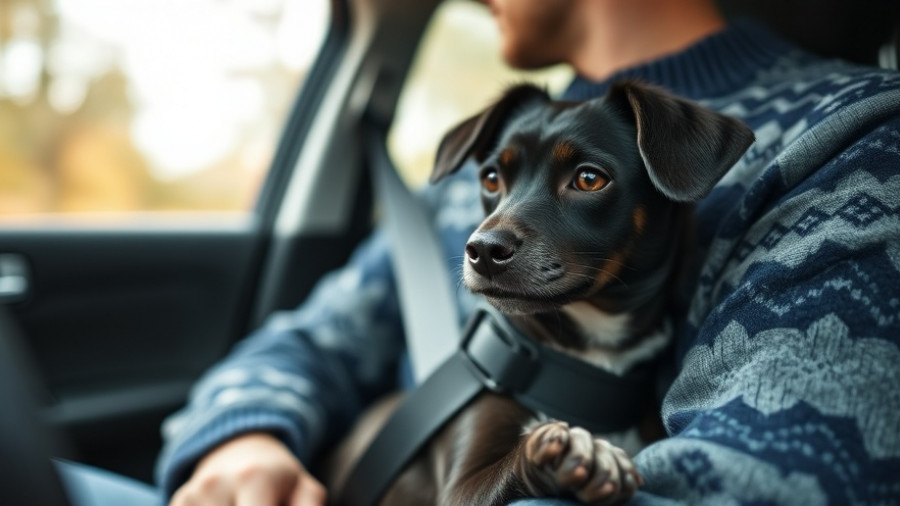
Keeping Your Furry Friend Safe in Hot Cars
As a dog owner, you're probably all too aware of the dangers that excessive heat poses to our four-legged companions. Every year, numerous dogs suffer severe heat-related injuries—or even die—due to being left in vehicles. Disturbingly, even on seemingly mild days, the temperature inside a parked car can escalate into a lethal oven within minutes.
The Science Behind Rising Car Temperatures
The American Veterinary Medical Association reveals shocking facts about temperature changes in vehicles: a car’s interior can heat up by 20°F in merely 10 minutes, regardless of the outdoor temperature. For example, on a 70°F day, temperatures can skyrocket to 89°F in 10 minutes and 104°F after 30 minutes. These rapid changes can spell disaster for your pet, particularly in an enclosed space like a car.
Unexpected Temperature Traps: What Dog Owners Should Know
The situation becomes more alarming when you consider that dogs cannot effectively cool themselves. Unlike humans who sweat all over, dogs primarily rely on panting as a cooling mechanism. If the ambient temperature exceeds their normal body temperature (around 101-102°F), panting becomes virtually ineffective. This makes conditions in a hot car extraordinarily perilous, especially for breeds with short muzzles like Pugs and Bulldogs.
Signs of Heat Distress: How to Tell If Your Dog Is In Trouble
Proactive dog owners should remain vigilant for early signs of heat distress in their pets. Look for excessive panting, confusion, bright red or pale gums, thick drool, vomiting, and even seizures. If a dog’s body temperature hits 104°F, serious organ damage can occur, with temperatures at 109°F often leading to fatal outcomes within just 15 to 30 minutes. It’s vital to understand these signs to act swiftly in case of an emergency.
The Temperature Danger Zone: When is it Too Hot for Your Dog?
The danger zone starts at an outside temperature of 70°F, where conditions within a vehicle become hazardous for dogs. The American Veterinary Medical Association warns that at 85°F, dogs can begin facing heat stress and illness. Just imagine: on a mild spring day, your car can transform into a sweltering 115°F environment within an hour. It’s essential to take these warnings seriously.
Immediate Action: What to Do When You See a Dog in a Hot Car
Seeing a dog left in a hot car can be distressing. If you notice a dog in such a situation, assess its condition. Signs of distress can signal serious trouble, and if necessary, it's crucial to call local authorities. However, be aware that breaking into a car could be considered criminal damage unless necessary for the dog's rescue—always err on the side of caution.
Alternative Solutions: What You Can Do to Prevent Heat-Related Emergencies
Before setting out with your dog, ask yourself whether it's absolutely necessary to take them along. If you can avoid taking them in the car, that may be best. When dogs must accompany you, invest in a safe, appropriate restraint system. Using pet harnesses and secured carriers can keep them safe during travel. And remember, never leave them in a parked vehicle!
Lasting Measures: Keeping Your Pet Cool and Comfortable
On hot days, consider simple yet effective measures to ensure your pet's comfort. Provide plenty of water, plan walks during cooler times of day, and consider using frozen treats like stuffed Kongs to keep them entertained while you’re gone. Avoiding areas that can trap heat, such as conservatories, can also create a safer environment for your dog.
Final Thoughts and Call to Action
Every dog owner must educate themselves about the risks of leaving pets in hot vehicles and understand the critical steps that can prevent tragic accidents. By staying informed and vigilant, you can ensure your beloved companion stays safe and healthy during those sweltering summer outings. Let’s create a community around pet safety; spread the word about these vital precautions to fellow dog lovers in your neighborhood.
 Add Row
Add Row  Add
Add 




Write A Comment